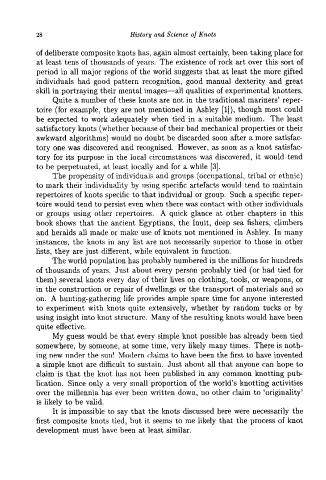Page 41 - J. C. Turner "History and Science of Knots"
P. 41
28 History and Science of Knots
of deliberate composite knots has, again almost certainly, been taking place for
at least tens of thousands of years. The existence of rock art over this sort of
period in all major regions of the world suggests that at least the more gifted
individuals had good pattern recognition, good manual dexterity and great
skill in portraying their mental images-all qualities of experimental knotters
Quite a number of these knots are not in the traditional mariners' reper-
toire (for example , they are not mentioned in Ashley [1 ]), though most could
be expected to work adequately when tied in a suitable medium. The least
satisfactory knots (whether because of their bad mechanical properties or their
awkward algorithms) would no doubt be discarded soon after a more satisfac-
tory one was discovered and recognised. However , as soon as a knot satisfac-
tory for its purpose in the local circumstances was discovered , it would tend
to be perpetuated , at least locally and for a while [3].
The propensity of individuals and groups (occupational, tribal or ethnic)
to mark their individuality by using specific artefacts would tend to maintain
repertoires of knots specific to that individual or group. Such a specific reper-
toire would tend to persist even when there was contact with other individuals
or groups using other repertoires . A quick glance at other chapters in this
book shows that the ancient Egyptians , the Inuit , deep sea fishers , climbers
and heralds all made or make use of knots not mentioned in Ashley. In many
instances , the knots in any list are not necessarily superior to those in other
lists, they are just different , while equivalent in function.
The world population has probably numbered in the millions for hundreds
of thousands of years. Just about every person probably tied (or had tied for
them) several knots every day of their lives on clothing, tools, or weapons, or
in the construction or repair of dwellings or the transport of materials and so
on. A hunting-gathering life provides ample spare time for anyone interested
to experiment with knots quite extensively, whether by random tucks or by
using insight into knot structure . Many of the resulting knots would have been
quite effective.
My guess would be that every simple knot possible has already been tied
somewhere , by someone , at some time, very likely many times. There is noth-
ing new under the sun! Modern claims to have been the first to have invented
a simple knot are difficult to sustain . Just about all that anyone can hope to
claim is that the knot has not been published in any common knotting pub-
lication. Since only a very small proportion of the world 's knotting activities
over the millennia has ever been written down, no other claim to `originality'
is likely to be valid.
It is impossible to say that the knots discussed here were necessarily the
first composite knots tied, but it seems to me likely that the process of knot
development must have been at least similar.

